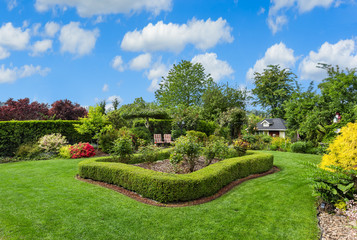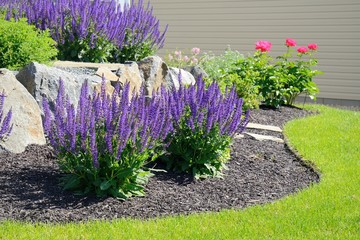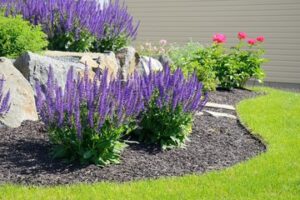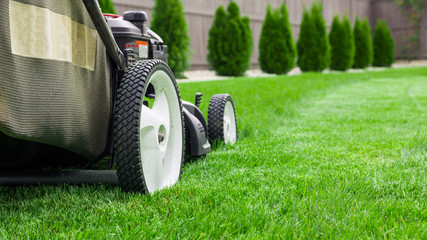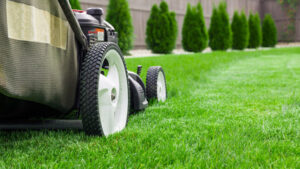Landscaping is the art of manipulating horticultural elements to create harmonious outdoor environments that serve functional purposes. It enhances property value, increases usability and adds beauty to the environment. It also reduces soil erosion, improves water quality and creates habitats for wildlife. Contact Landscaping in Greensboro NC for professional help.
Choose a variety of plants that offer color, texture and structure. For example, liriopes and sedum are ground covers with interesting foliage and flowers. Also consider evergreen trees and shrubs that provide year-round color and structure.
The beautiful rust-like look of corten steel has made it popular for both landscaping and garden design. Its rugged appearance adds a natural touch to any outdoor space, and its unique coloration provides a perfect complement to greens and floral colors found in most landscaping designs. This material is also incredibly durable and resistant to moisture. It can withstand extreme temperatures and strong winds without compromising its structural integrity. Additionally, it does not require paint, which reduces maintenance costs and avoids the problems associated with volatile organic compounds.
Corten steel is a type of weathering steel that naturally creates a protective layer of rust. This protects the inner steel from corrosion, making it a great choice for outdoor applications. Its distinctive reddish-brown color and textured surface give it an attractive aesthetic, which makes it an ideal choice for contemporary architecture. Corten steel was originally designed to help build railroad coal wagons, but its success led to its use in outdoor sculptures and architecture. Corten steel contains alloys of copper, nickel and chromium that make it more durable than other types of steel. These alloys also enhance its ability to resist corrosion.
Once the rust coating on the outside of the steel has formed, it forms a protective barrier against the elements. This protection prevents rust from penetrating the metal, which is why it is so durable. This protective layer is called a patina, and it can last for up to 36 months, depending on the conditions.
When used in landscaping, a corten steel lawn edging is a cost-effective solution for creating straight lines in your garden or yard. These edgings are available in several lengths and are easy to install. Dig a trench along the edge of your landscaping area, and then set the edging in place. Use a spirit level to ensure the edging is properly aligned and leveled. Then, backfill the trench with soil and compact it to hold the edging in place.
Although corten steel is a very durable material, it does not last as long when exposed to prolonged dampness. It is important to keep it dry, and it should never be used in coastal areas or areas that will remain wet for extended periods of time. For this reason, it is recommended that the edging be installed in an open area with adequate ventilation. Corten steel can also be sealed to prevent water from damaging it.
Smart concrete
Concrete’s versatility and durability make it a valuable landscaping material. Compared to other materials, it requires less maintenance and repairs, which reduces costs. It also demonstrates impressive fire resistance, which helps prevent the spread of flames in outdoor environments. Landscaping professionals use streamlined installation techniques to reduce labor costs, making concrete an affordable option for homeowners.
The evolution of construction technology has led to the development of smart concrete, which is infused with sensors that detect changes in its internal structure and conditions. These innovative technologies have the potential to change the way we build, allowing us to monitor and respond to structural problems before they escalate into major disasters.
MIT’s self-healing concrete, for example, contains bacteria that release calcium carbonate to fill in cracks and restore the material’s strength. Other innovations include glow-in-the-dark concrete, which incorporates luminescent particles that light pathways at night without the need for external lighting. Concrete that generates energy, meanwhile, converts the kinetic energy of footsteps into electricity.
Another type of smart concrete consists of embedded fiber optic sensors that monitor the material’s condition. These sensors, known as FBG (fluorescent bandgap grating) strain sensors, can detect autogenous shrinkage strain, temperature, and relative humidity during curing. Using this data, engineers can optimize the curing process to obtain smart concrete with desirable properties.
This smart concrete allows contractors to improve the quality of their work and avoid costly repairs. The sensors provide real-time feedback on the performance of concrete structures, enabling them to anticipate any changes in their behavior. In addition, they can help reduce traffic congestion caused by repair and maintenance projects.
Intrinsically smart concrete is composed of cement fine aggregate, coarse aggregate, steel fibre, water, and a super plasticizer. The addition of these materials enhances the performance of traditional concrete by lowering its viscosity and increasing its tensile strength. It also provides a better bond between the aggregate and the matrix, ensuring long-term durability. The resulting product combines the best features of concrete and asphalt. Its low permeability and tensile strength make it ideal for use in pavements and bridges.
Composite wood
Composite wood is a mix of various materials, including cellulose, hemicelluloses, and lignin that are held together in a matrix. This makes it more durable than solid wood, and resistant to rot, mold, and insect damage. The material can be molded into different shapes and sizes, making it an ideal choice for landscaping projects that require a long-lasting material. The material also comes in a variety of finishes to appeal to any aesthetic tastes, from natural-looking to rustic or contemporary.
A popular choice for exterior builds, composite wood has many benefits over traditional timbers, including low maintenance and durability. It is also a sustainable option, as it uses recycled plastics and wood that would otherwise end up in landfills. In addition, the recycled plastics help reduce demand for tropical hardwood, reducing the pressure on global forestry harvesting.
Composite wood can be used in a variety of applications, from decks and patios to trash bin enclosures and cladding. It can also be incorporated into concrete and cement board for added strength. The material is a good choice for high-traffic areas, such as commercial patios, because it can withstand the demands of heavy foot traffic and weather conditions.
There are several types of composite wood, and each has its own advantages and disadvantages. Some are made from a combination of wood and plastics, while others use a mix of natural-looking and synthetic materials. The type of wood composite you choose will depend on the kind of look you are trying to achieve and your budget.
One of the most common kinds of composite wood is plywood. It has been around for over a century, and is still used today. It is composed of layers of wood veneers that are glued together to create thin, strong boards. Other types of composite wood include particleboard, which uses a blend of recycled wood and other materials, and medium-density fiberboard, or MDF. These products are produced by combining wood chips or fibers with adhesives under high heat and pressure.
Another type of composite wood is laminated veneer lumber, which is made from strips of wood that are bonded together with waterproof adhesives. It is used in place of structural lumber, such as floor beams and headers. Other types of composite wood include oriented strand lumber and laminated strand mats, which are made of strands of wood or other material bonded together with waterproof glues.
Reinforced stone
The right material is crucial for your landscaping project, and you want to choose a material that is both durable and beautiful. There are a few options available to you, including concrete and natural stone. Each of these materials has unique benefits and uses, so it’s important to weigh the pros and cons of each before making a decision. Natural stone is a popular option because of its durability and timeless look. It is also easy to maintain and repair. However, weeds can grow between the stones, so you’ll need to lay mulch regularly. Concrete, on the other hand, requires more maintenance to keep it looking clean and fresh.
Reinforced stone is a great choice for landscape projects because it is flexible and can take on intricate forms. It can be used to create anything from simple retaining walls to ornate artistic sculptures and tranquil water features. This versatile material can be shaped to fit the needs of the landscape, and it is a cost-effective solution for any landscaping project.
One of the most common uses of reinforced stone is to reinforce soft soils. This technique is particularly effective when the site conditions are not favorable for conventional retaining wall construction. In addition to strengthening the soil, this method provides a better foundation for the footings of buildings and other structures. Model tests on short, floating, and fully penetrating single columns show that the failure stress of composite ground improved with reinforcement can be significantly reduced compared to the unreinforced case. This improvement can be achieved either by encasing the stone columns or by placing horizontal strips of geosynthetics within the columns at regular intervals.
If you have a pool, garden, or patio at home, it’s essential to protect your property from erosion. A retaining wall can help shape your outdoor space to reduce the risk of flooding, and it can also prevent soil erosion around your house. Additionally, a retaining wall can be built with reinforced stone to create a more stable base for your garden.
Reinforced stone grates are also a great choice for your landscape. These grates are durable, heat-resistant, and corrosion-resistant. They’re also slip-resistant and can be made to match your landscape design.
